Artificial substrates
The substrates were produced in two halves to facilitate the extrusion process and the inclinations of the shape. Finally, the halves will be joined and secured at both the upper and lower ends using metal hooks. This concept will function as a floating artificial reef, similar to aquaculture methods, to help promote a different type of marine habitat.










































